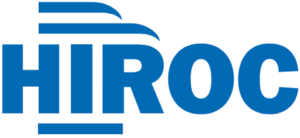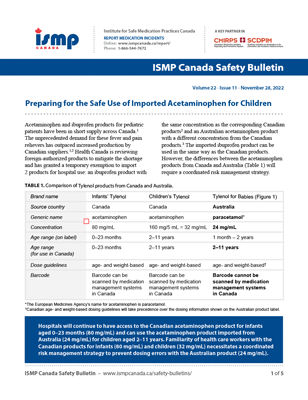Preparing for the Safe Use of Imported Acetaminophen for Children
Acetaminophen and ibuprofen products for pediatric patients have been in short supply across Canada. Health Canada is reviewing foreign-authorized products to mitigate the shortage and has granted a temporary exemption to import an Australian acetaminophen product for hospital inpatient use only, with a different concentration from the Canadian product. The differences between the acetaminophen products from Canada and Australia will require a coordinated risk management strategy. Read this bulletin to learn how to reduce the risk of mix-ups and dosing errors in hospitals.
Health Canada has also authorized the importation of different acetaminophen products for retailers. The bulletin sidebar shares recommendations for community pharmacists to support the safe administration of imported acetaminophen products.
INTRODUCTION
Acetaminophen and ibuprofen products for pediatric patients have been in short supply across Canada.1 The unprecedented demand for these fever and pain relievers has outpaced increased production by Canadian suppliers.1,2 Health Canada is reviewing foreign-authorized products to mitigate the shortage and has granted a temporary exemption to import 2 products for hospital use: an ibuprofen product with the same concentration as the corresponding Canadian products2 and an Australian acetaminophen product with a different concentration from the Canadian products.3 The imported ibuprofen product can be used in the same way as the Canadian products. However, the differences between the acetaminophen products from Canada and Australia (Table 1) will require a coordinated risk management strategy.

Hospitals will continue to have access to the Canadian acetaminophen product for infants aged 0–23 months (80 mg/mL) and can use the acetaminophen product imported from Australia (24 mg/mL) for children aged 2–11 years. Familiarity of health care workers with the Canadian products for infants (80 mg/mL) and children (32 mg/mL) necessitates a coordinated risk management strategy to prevent dosing errors with the Australian product (24 mg/mL).

FIGURE 1. The Australian Tylenol® for Babies product containing paracetamol (acetaminophen) 24 mg/mL is being imported to alleviate the shortage in Canadian hospitals. Image courtesy of Johnson & Johnson Inc.
The introduction of imported products into the medication-use system must be carefully managed to mitigate risks, such as the potential for medication errors.4 Hospitals that will be using the acetaminophen product imported from Australia will need a multipronged systems approach to reduce the risk for errors. Consider the following strategies, bearing in mind that this is not an exhaustive list.5
INTERDISCIPLINARY PLANNING
- Identify a decision-making and communications group to introduce the imported product, to coordinate ongoing communication and education, and to monitor the supply situation. All decisions, rationale, and outputs (e.g., newsletters, posters) should be well documented.
- Prepare a plan to safely transition back to the Canadian acetaminophen product, remove the imported product, and revert to original resources, systems, and processes (where these were modified) once the time-limited shortage ends.
PHARMACY PREPARATION, STORAGE, AND DISPENSING
- Determine, using pictures and labels of the imported product, whether additional information or steps are required to safely integrate the product into the medication supply. Consider the need for
- updated dispensing processes (e.g., patient- specific unit doses) to prevent calculation or dosing errors;
- an auxiliary warning label to alert practitioners to differences in name and concentration (e.g., “This product contains acetaminophen (paracetamol) 24 mg/mL”); and
- an updated barcode database and application of an additional barcode to scan within Canadian medication management systems.
- Store each available acetaminophen concentration (i.e., 80 mg/mL for infants and 24 mg/mL for children) in separate care areas or at least in separate, labelled containers within the same area.
- Consider signage in appropriate places (e.g., storage cupboards on nursing units, pharmacy stock shelves) to communicate information about the imported product.
SUPPORTING RESOURCES, SYSTEMS, AND PROCESSES
- Determine updates that may be required for any of the following paper-based or electronic resources, systems, and processes:
- order sets or computerized order entry systems
- formulary and other drug information resources
- medication administration records
- quick reference charts and dosing guidelines
- medication reconciliation at transitions of care
- independent double checks, where appropriate
- pharmacy, materials management, and finance systems
PATIENT/FAMILY ENGAGEMENT
- Alert parents and caregivers to the supply situation, and advise them to consult with their community pharmacist after discharge for guidance on the correct dose and volume of acetaminophen products available in the community.
- The Australian acetaminophen product described in Table 1 has been imported for hospital inpatient use only and is not permitted for outpatient use. Different imported acetaminophen products have been made available in the community (as described in the accompanying bulletin supplement).
- Ensure that the patient’s weight is accurately measured and communicated to the family (with corresponding units) before discharge, for use in weight-based dosing.
Errors, near misses, and safety concerns related to the imported product should be reported through the hospital’s usual reporting mechanism. Sharing reports with the Canadian Medication Incident Reporting and Prevention System reporting programs (https://ismpcanada.ca/report/) will help in identifying concerns and will inform continuous improvement opportunities.
![]()
The Canadian Medication Incident Reporting and Prevention System (CMIRPS) is a collaborative pan-Canadian program of Health Canada, the Canadian Institute for Health Information (CIHI), the Institute for Safe Medication Practices Canada (ISMP Canada) and Healthcare Excellence Canada (HEC). The goal of CMIRPS is to reduce and prevent harmful medication incidents in Canada.
Funding support provided by Health Canada. The views expressed herein do not necessarily represent the views of Health Canada.

The Healthcare Insurance Reciprocal of Canada (HIROC) provides support for the bulletin and is a member owned expert provider of professional and general liability coverage and risk management support.

The Institute for Safe Medication Practices Canada (ISMP Canada) is an independent national not-for-profit organization committed to the advancement of medication safety in all healthcare settings. ISMP Canada’s mandate includes analyzing medication incidents, making recommendations for the prevention of harmful medication incidents, and facilitating quality improvement initiatives.
Report Medication Incidents (Including near misses)
Online: ismpcanada.ca/report/
Phone: 1-866-544-7672
ISMP Canada strives to ensure confidentiality and security of information received, and respects the wishes of the reporter as to the level of detail to be included in publications.
Stay Informed
Subscribe to the ISMP Canada Safety Bulletins and Newsletters.
This bulletin shares information about safe medication practices, is noncommercial, and is therefore exempt from Canadian anti-spam legislation.
Contact Us
Email: cmirps@ismpcanada.ca
Phone: 1-866-544-7672
©2025 Institute for Safe Medication Practices Canada.
